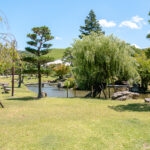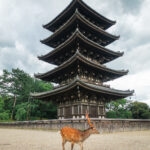This post may contain affiliate links. Please read our disclosure policy.
Kasuga Taisha in Nara is famous for its vermilion halls, sacred deer, and thousands of stone and bronze lanterns, creating one of Japan’s most enchanting shrine settings.

What Makes Kasuga Taisha Special
The Wild Deer of Nara Park
One of the most memorable parts of visiting Kasuga Taisha is sharing the grounds with Nara’s free-roaming deer. In Shinto belief, these deer are messengers of the gods. They wander through the park and often approach visitors, especially if you’re holding deer crackers. While they look gentle, we reminded our kids that they’re still wild animals and can get a little pushy.
Lanterns Like No Other

Kasuga Taisha is home to over 3,000 lanterns, crafted from stone and bronze. They line the approach paths, hang from shrine eaves, and stand in mossy clusters around the grounds.
Twice a year, during the Mantoro Lantern Festivals (Setsubun Mantoro in February and Chugen Mantoro in August), every lantern is lit at night. We didn’t visit during the festival, but we stepped into Fujinami-no-ya Hall where lanterns glow year-round. The dim light and shadows gave us a small taste of that magical atmosphere.
Spiritual Architecture and Color

Built in the Kasuga-zukuri style, the shrine’s architecture stands out with its vivid vermilion columns and white walls framed by lush greenery. Passing through the central gate, we entered a courtyard filled with shrine halls stretching in both directions. The main sanctuary isn’t always open to the public, but even without entering we found plenty to explore—lantern halls, smaller shrines, and forested trails leading into Kasugayama Primeval Forest.
Additional Attractions Near the Shrine
After visiting the main complex, we stopped at a few nearby highlights:
- Kasuga Taisha Museum – Displays ritual treasures and artifacts tied to the shrine’s long history (admission required).
- Man’yo Botanical Garden – Features over 250 plant species mentioned in the Manyoshu, Japan’s oldest poetry anthology.
- Kaoh Shop – A small shop where we enjoyed green tea soft serve, perfect for a break on a warm day.
Fascinating Facts About Kasuga Taisha

- Established in 768 AD, the shrine was rebuilt every 20 years following Shinto tradition until the late 19th century.
- Together with Kasugayama Primeval Forest, it forms part of the UNESCO World Heritage Site “Historic Monuments of Ancient Nara.”
- It is the most important Shinto shrine in Nara, while most of the other major landmarks are Buddhist temples.
- Four main deities are enshrined here, each with its own altar—a rare setup in Japan.
- More than 2,200 rituals are held annually, including daily ceremonies praying for peace and happiness.
How to Get to Kasuga Taisha
Kasuga Taisha sits inside Nara Park and is easy to reach from the city’s main stations.
By Train and Bus
- From JR Nara Station or Kintetsu Nara Station, take a local bus to Kasuga Taisha Honden. Walk a few minutes to the shrine.
- Bus routes are posted at both stations, and IC cards are accepted.
On Foot
- From Kintetsu Nara Station: about 30 minutes through Nara Park.
- From JR Nara Station: about 40 minutes through Nara Park.
By Taxi
- About 10–15 minutes from either station, depending on traffic.
Pro Tip: Arrive early morning or late afternoon for softer light on the lantern paths and fewer tour groups.
Is Kasuga Taisha Worth Visiting?

Absolutely. Kasuga Taisha is magical for families and solo travelers alike. Kids love spotting the friendly deer, while adults can take in the lantern-lit paths and centuries-old architecture. Between the history, the nature, and the peaceful vibe, it’s easy to spend hours exploring.
More to Explore Nearby
As a majestic Shinto shrine located deep in Nara Park, Kasuga Taisha is the perfect starting point to explore Nara’s historical heart, putting you close to massive temples, the popular deer park, and traditional local cuisine.
- Todai-ji Temple – Head over to this monumental temple complex to see the world’s largest bronze statue of the Buddha in the largest wooden building on earth.
- Nara Park – Wander through the sprawling public park surrounding the shrine, famous for its thousands of friendly, freely roaming wild deer.
- Kofuku-ji Temple – Discover the site of Nara’s iconic five-story pagoda, one of the oldest and most historically significant temples in the city.
- Naramachi – Explore the preserved old merchant quarter, characterized by narrow streets, traditional wooden houses, and quiet cafes.




